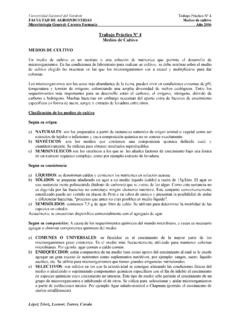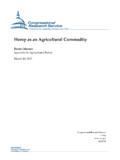Transcription of World Agriculture Towards 2030/2050
1 SUMMARY. World Agriculture Towards 2030/2050 : The 2012 revision Current UN projections indicate that World population could increase by more than two billion people from today's levels, reaching billion by 2050. Incomes will grow even faster. To meet increased demand, FAO projects that global agricultural production in 2050 will be 60 percent higher than in 2005/07 (see box). This is a smaller increase than the Agriculture sector has achieved over the past half century, but still raises concerns about how it can be achieved sustainably. This report is the latest in the series by the Global Perspective Studies unit within FAO, which aims to provide insights into how food and Agriculture may develop between now and 2050, making note of key assumptions and uncertainties and incorporating the wide range of technical expertise found throughout FAO on likely paths of development and constraints.
2 Given increasing complexity and uncertainty, future outlooks will also draw on new tools to explicitly assess different scenarios and assumptions. Expected developments in food and feed demand are subject to less uncertainty than other factors particularly demand arising from novel uses of agricultural products such as biofuels and the underlying constraints relating to land and water resources but all play a role in the outlook presented in this paper. The main drivers: population and income The expected slowing of World population growth over the next 40 years means that agricultural production and consumption are also expected to grow less rapidly.
3 The growth rate varies considerably across countries, however, and those countries whose populations continue to increase rapidly are precisely those that currently exhibit high levels of undernourishment. Many of these are in sub-Saharan Africa, which is expected to account for around 20 percent of the World 's population by 2050. Global GDP is projected to grow by 2050 with per capita income growing , resulting in a World that is richer and characterized by less- pronounced income gaps between developed and developing countries. But aggregate income growth alone is not expected to eliminate poverty and undernourishment.
4 Of the 45 developing countries with a per capita GDP. below US$1 000 today, 15 will remain in this classification with its associated levels of per capita food consumption and undernourishment in 2050. Structural change in diets: Towards satiety and beyond While population and income growth will spur demand, significant parts of the World will approach saturation of per capita consumption levels. The result is a halving of annual demand growth to percent per annum a combination of developed countries having completed the transition to livestock-based diets and some large developing regions progressing more rapidly Towards higher consumption levels (Figure 1).
5 Convergence Towards developed countries' consumption patterns is not inevitable for all countries, however, if only for cultural reasons. Demand will increase in both developed and developing countries, even where current levels appear adequate and additional growth may cause Agricultural health concerns. This may happen even in countries where undernourishment Development remains significant. As a result, by 2050, some 52 percent of the World 's Economics Division population may live in countries where average calorie intake is more than 3 000 kcal/person/day, while the number of people living in countries with an average below 2 500 kcal may fall from billion to 240 million.
6 Undernourishment, however, remains a Figure & 1: Per capita food consumption . challenge (kcal/person/day).. The 1996 World Food Summit adopted a target of . halving the number of undernourished people in . developing countries, which stood at 810 million in . 1990 92, by 2015. FAO's latest estimate indicates . there were 827 million undernourished in 2005/07.. Although the proportion of population who are undernourished fell, absolute numbers increased . slightly with the rise in population. The proportion . of people who are undernourished is expected to.
7 Fall by about 4 percentage points by 2015 (Figure 2), . although the absolute target may not be achieved :RUOG 'HYHORSHG 'HYHORSLQJ 6XE 6 DKDUDQ 1 HDU (DVW . $IULFD . /DWLQ . 1 RUWK $IULFD $PHULFD . 6 RXWK $VLD (DVW $VLD . &DULEEHDQ . before the 2040s. Progress is expected to be slow .. because countries with low food consumption and & . high prevalence of undernourishment in 2005/07 . are also those where population growth is likely to . Figure 2: Undernourishment in developing countries .. be highest.. Production growth slows, but absolute.))
8 Increases are expected to be significant .. Projected growth rates in production may be . smaller than those of the past, but in absolute terms production is expected to rise significantly :)6 WDUJHW IRU PLOOLRQ 0 LOOLRQ 3 HUFHQW RI SRSXODWLRQ ULJKW D[LV . for the main product groups (Figure 3). Achieving . such increases will be more difficult than in the .. past. Land and water resources are increasingly . stressed and are becoming more scarce and .. diminished in quality due to resource degradation and competition from uses other than for food Figure 3: World production and use, major products production.]
9 (billion tonnes) How will production respond? Contributions to growth In aggregate, most of the increase in production (more than 85 percent) over the next 40 years is expected to derive from improved yields (Figure 4). Some gains will also come from higher cropping intensity, predominantly in developed countries. Yield growth has been the mainstay of historic production increases and will continue to play this role into the future. Average cereal yields have been growing in a nearly linear fashion for the past five decades (Figure 5), implying a falling growth rate.
10 Some regions, notably sub-Saharan Africa and Latin America, may grow faster than the linear trend, provided that economic and institutional conditions are conducive. Local constraints to increasing yields remain a significant concern in many countries, threatening improvements in local food supplies in countries where they are most needed. After accounting for differences among countries, global cereals yields are projected to increase from tonnes/ha in the base year to tonnes/ha in 2050 (Figure 5). World average yields for other major crops follow similar patterns.















